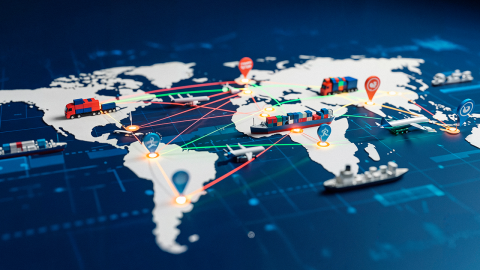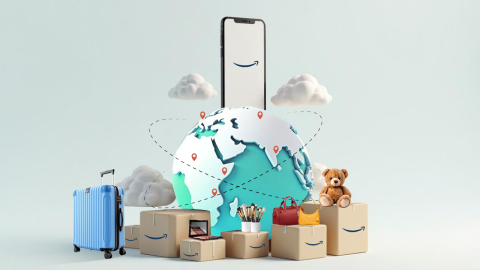On Day 2 of Amazon Smbhav, saw a lively session on ‘Building and Innovating for Indian customers’ with two very distinguished speakers representing two organizations. One was Sudhir Sitapati, Managing Director and CEO, Godrej Consumer Products and the second speaker was Russell Grandinetti, Senior Vice President, International Consumer, Amazon.
Raghava Rao:
Sudhir, my first question is to you. You lead an organization that's in the business of building brands for consumers. Essentially, you buy raw material, and you convert and manufacture the raw material into finished products. You distribute these products across customer selling points, and then you market them. What exactly is the role of innovation across this value chain and where do you think it is most effective?
Sudhir Sitapati: I think Raghav it will be easy for me to say that innovation is effective across the value chain. But the truth is that in consumer goods businesses the way you phrase it, innovation is far and away most important. And you know, what you're calling conversion of raw materials to finished goods, which is to solve unsolved consumer problems with products. And that's the heart of innovation. I mean, obviously, there's innovation and media and sales and distribution, etc. But this is really the role of consumer goods companies. And we should keep, sort of remembering the fact that these are chemical engineering companies, chemical technology companies that solve, you know, unfulfilled consumer needs in this space.
Raghava Rao: Thanks, Sudhir. Russ, my next question is to you, what is it that excites you most about India? And perhaps what is it that worries you about India?
Russell Grandinetti: Well, the excitement is pretty palpable, every time I come. I mean, the actual level of, I might even start with, “hustle” and “energy”. I see both from our own teams and from our selling partners, and frankly, from the marketplace, in general. Things move quickly. And the cleverness, the creativity, the willingness to see an opportunity and run towards it. I think India ranks as high as any other country I can get the chance to go visit. I will say, there’s a little bit of the other side of this coin that maybe answers the other thing- which is things can change so quickly. Sometimes the ground can move under your feet in ways that are surprising. So, we just have to pay attention and look out, and be willing to be nimble and flexible. That could be technology, it could be infrastructure, it could be regulatory concerns, it could be lots of different things. And the pace of change, I think, is so great that any organization, us, or any other here, has to almost be prepared for and embrace that kind of change, and almost organize for it. And we do our best to do that. But it takes hard work to stay on top of the wave, that’s for sure.
Raghava Rao: Russ, you joined Amazon when it was a small company, a small organization that probably sold just books. Today, you lead an organization that is several times the scale of what it was when you joined. So, what stories can you share about how Amazon has innovated and grown so fast? And what's the role played by innovation in that growth journey?
Russell Grandinetti: Well, it's true. When I joined the company, there were maybe not even 100 people in the office. And we were a small business like any other here. I worked, even during the first holiday season in 1998. We couldn't hire enough staff for the Christmas rush. And we all worked a day job at the office and then worked the night shift in the fulfillment center from about 8 at night till about 2:30-3 o'clock in the morning for those six weeks of the holiday. Like any small business, we worried about competition, and we worried about keeping up with demand if we were lucky enough to have it, and we worried whether demand would show up. But a lot of the way that we talked about the business is the same as it is today. And probably the principal way is just about focusing on the customer and asking what she or he wants, and how do we get it to them. And then that same simple set of questions applies to when we then started selling at that time, VHS tapes, or CDs, and then, all kinds of categories and in all kinds of countries.
There are still a few of us from that time walking around Amazon, and we try to help people understand that our way of thinking about the business, you know, doesn't necessarily change just because the company has grown a bunch. And I feel very good about the degree to which that culture is still held in the business today. I think the innovation point is really I agree with what was just said, which is companies often want to try to make products they want customers to buy, as opposed to make products customers want to buy. The desire to try to convince people to do the thing you built as opposed to build the thing they're hoping for, and maybe didn't even realize they were hoping for is a very subtle but very real thing that all companies run the risk of falling prey to. And so that innovation- by the way, when you define it that way, you don't first say “am I capable of doing it? Is it possible?” And then sometimes you get a little feeling in the pit of your stomach about “I know customers want that but how am I going to do that? What do I need to learn what skills do I need to acquire? How do I need to change what's going on that can create discomfort?”
I think that discomfort is a little like going to the gym. You know it's good for you, you get stronger, but it takes hard work and a little bit of pain to power through. I think when we're at our best, that is the way Innovation often happens, we build skills, we add capabilities, and we move out of our comfort zone, in some way. But if we're really paying attention to what people want, there are good things on the other side of that.
Raghava Rao: Thanks, Russ. You spoke about moving out of the comfort zone. Sudhir, that brings me to the next question for you. Godrej is a company that has served customers and consumers in India. And I guess in a way you moved out of your comfort zone, to now start serving consumers in Asia, in Middle East Africa and parts of Latin America. What's this journey been like? And how alike, and how different are your consumers in these different geographies?
Sudhir Sitapati: Raghav, Godrej is part of my experience. But even when I was in my previous company, which was Unilever, where we were together- one of the things that I realized is that consumers across the world are surprisingly similar. And I'll give you an example. When I was doing a consumer group in Paris and didn't speak French, I was kind of at sea. I didn't know what to say to consumers. So, I used a technique that I use in rural India, which is I introduced the word mother-in-law into the conversation and even all the French women started tittering. Because everyone had the same feeling towards their mother-in-law, whether a poor Indian village or in like, you know, in a posh place in France.
So, I just feel like consumers, and I've just come out of traveling to Indonesia, I've been traveling in Africa, and I find consumers surprisingly alike in what they want. Manufacturers trying to find complexities which differentiate consumers, the overwhelming variable that differentiates consumption, because you know, the way I think about this consumption, right are the product categories we operate, the variable is income. There are other variables, right, but 75 to 80% of the variance in consumer behavior can just be understood by whether it's a $2,000 per year consumer or $4,000, or a $10,000, $20,000, or $40,000. Right? So that I would say, that's the variable that I used to understand and then variances across this curve. One can then find some other explanatory variables like culture etc. So, my broad answer to that is a consumer is the same, income being the big differentiating variable. And then you will find a few others that, you know, start to make a difference. But that's anyway the mental model with which I approach consumers across the world.
Raghava Rao: Thanks, Sudhir. A similar question to you, Russ. What is it about Indian consumers that has surprised you? And what is it that didn't surprise you, because you oversee a large part of Amazon's journey in India.
Russell Grandinetti: I'll start with what I heard. Sudhir says because I agree with him entirely about the commonality of consumer demand. So, this sort of isn’t a surprise. Retail is a very local business- How it’s conducted and who customers choose, you know, might look somewhat different in the UK, or Japan, or Brazil or India. But nowhere in the world do customers want less choice or higher prices or slower service. Those things are uniform, even if how they manifest themselves, can vary quite a bit.
Indian customers are no less interested in a good deal or a great product. I think, maybe in a positive way, when we started some of the things about buying online were, you know, quite a bit more difficult for some Indian consumers than in some other places around the world. I mean, a really good example, back then, eight years ago, was just paying for things. You know, we were in a very different state in India in terms of digitized payment, for example, and a combination of company invention, a combination of regulatory advancement, a combination of a whole lot of different forces have now made that a different landscape today.
And there's still lots of improvement, I think, to reach as many consumers as possible in the course of time, but, almost how hard customers worked to be customers of our business, once we got able to offer them something of interest was really impressive. And then you sort of turn that around, and the speed with which customers in India suddenly take something they were delighted to have last year and think it's normal today, and will probably be frustrated by it next year, because their expectations go up so quickly. I think that's one of the other things that all of us have to try to make sure we don't lose sight of, like staying the same as actually going backwards.
Raghava Rao: Russ, innovation is something that many of us associate with small companies. Typically, people romanticize innovation with startups that were founded in garages, etc. My question to you is how does the ability of a company to innovate change when it grows in scale? And how do you as a leader prevent bureaucracy from stifling innovation as an organization scales?
Russell Grandinetti: Well, I think we’ve just said a little bit. Innovation, no matter what your scale is, is trying to have a vision for what you should build or invent that people- your customers- might like. And then organizing the skills in the process to make it happen. Now. Even if you get bigger, what does that involve? That involves clarity of vision, which involves the willingness to take risks. So, I think one thing, a bigger company might run the risk of being so focused on protecting the way things are today, it’s not willing to change and take risks to change what it’s doing. And so like building the culture around when you try things, and they don’t work out, getting to the root cause of what you thought, why you thought it, what you can learn from it’ how to build on that, and then as a leader, demonstrating that you're not going to, you're not going to penalize the right kind of risk-taking actually you embrace it, as long as people sort of doing that other piece that I just talked about, which is like squeezing lessons out of it and changing and adapting. I think setting an example as a leader is really important. I’m inspired by the people I work within that regard, and I do my best to try to reciprocate.
Raghava Rao: Sudhir, India like many countries, has seen the emergence of e-commerce as a significant channel for consumer product companies, including Godrej. How do you see this channel of e-commerce evolving in future? What is your take on it?
Sudhir Sitapati: I mean, Raghav, I think it'd be ambitious for me to talk about how e-commerce will evolve in the future. Frankly, you guys know this better than I do. But let me tell you how much and so I don't want to sort of go there. But let me tell you what I think about as a CPG company. Look, our competitive advantage, as I told you, is in the design of products that solve unsolved needs, right? For me a channel is like a new road toward the same destination. I'll, you know, make sure that we are cast and travel on that. I don't spend a huge amount of time thinking about the evolution of a channel. I spend a reasonable amount of my execution saying that whatever channels consumers are shopping in, are our brands visible and available in those channels, right? So that's really important today for me – if the salience of e-Commerce in groceries is X, Y Z- in those channels we are present, is something that I spend a lot of time thinking about. As far as the future goes, I spend a lot of my time thinking about what products will they use that day- hair care or household insecticide? And what are the unsolved needs there? So that's how I choose to spend my time and when guys like you are obviously a much better place to evolve this world of e-commerce and we will ride on that, you know, as suppliers to your industry. So yeah, that's how I think about it.
Raghava Rao: Sudhir sitting today in India, what consumer trends do you see taking shape and are relevant for the future?
Sudhir Sitapati: Yeah, Raghav. You know, one big consumer trend I see everywhere in the world is this trend of globalization. It sounds simple to say, but you know, as I travel these days, across the world, I find airports the same, hotels the same, the food the same, I find people working on the same software, and it wasn't the case 10 or 20 years ago, the world was a different place. So, I mean, I feel that's the real meta trend that's sort of driving the world, which is kind of moving towards a pretty large degree of sameness. That pace of change I find in India in particular, is faster than the periphery.
You know, I was traveling a few months ago to this town of Ahmednagar. And I'd been there last, 10 years ago. It's quite interesting in my job, it's like a time warp, you go to a place where you've been 10 years ago, because you have a good memory of what you saw and what you see now. And the core of the city was the same. It was an old wholesale market with dirty streets and cows and so on, so forth. You went to the outer periphery, you started seeing hotels and hospitals. And then when you went to the outer periphery, what I had seen was villages and farms, you actually saw the most modern part of the city. So, you have three concentric circles, the inner core, pretty much not changing, and the outer core changing the most and being part of a global entity. So, the big change that I see is the change in the periphery. When I think about India, and where I think, change is going to innovation- it's the periphery of economic activity where I feel like the fastest change is going to happen. So, I think that's one of the trends I see in India.
Raghava Rao: Russ, back to you, and maybe a question on Innovation. I wanted to hear your thoughts. Innovation is a function of culture? Or do you think it’s a function of capability? Or is it just serendipity? And how do you mechanize innovation? As an organization scales? What is it that you do to try to make sure that innovation keeps being generated by that organization?
Russell Grandinetti: I'd be reluctant to tell you, it's any one or not any one of those things. So, you know, serendipity means a little bit, surprisingly, out of the blue in an unplanned way an idea comes to you. And that's always possible. But I don't think, you know, sitting under the apple tree, waiting for the apple to fall on your head and thinking about gravity is the only way to go about inventing something, or discovering something, or realizing something. In fact, we have some methods we use to try to organize innovation. I think it's particularly important when you're talking about doing it among a group.
And the reason is, if I just tell you the pitch outline of an idea of a thing, I think we should go build, 10 people could hear that, and 10 people might go away and go build a different thing. So we have some mechanisms inside our company, where we, for example, write down a press release, not something we'd actually end up sending out at the end of the day, but we try to actually write down in some great detail, what the end state of the product, we're going to go build or the invention we're going to go do is, and ask some questions about that, you know, how does it work, and a whole bunch of different things. And we try to clarify what the end result of our building process is going to look like when we debate how interesting that would be to people and how successful it might be, and all of those things. And then the engineering teams can go away and actually build something they know is going to meet that end purpose, or you know, or the marketing team, or the operations team or whatever.
So, there are ways to have mechanisms that let invention take hold. And I think even part of it is just a willingness to play with ideas that seem impractical or not worthy for a little while until you reshape them. You know, we've had many major inventions at Amazon, whose first, second and third iterations failed quite badly. For one reason or another. And so, if the core idea is there, sometimes it also requires that kind of perseverance and tinkering in v2 and v3 and v4. If you have conviction about what you're really doing. That's hard to do. It's hard to know if you are right. But I do think it's a muscle you can exercise. And I do think it's a thing that you can improve your chances of having to happen, the way you organize and the processes you use.
Raghava Rao: Russ, consumer technology companies tend to be fairly centralized in their decision making. Amazon, on the other hand, believes in empowering the part of the organization that is closest to serving the customer. So how do you manage that tension that you probably have in the organization of being global in scale? And at the same time being relevant and competitive locally? So how do you manage local versus global within your organization?
Russell Grandinetti: Well, maybe the most central idea is certainly in the way our team works together. I try to figure out that anytime I'm required to make a decision, I think about it as a defect. And I asked myself how I could push that decision making down into the organization. And frankly, even as a business, we then distribute it even further to our selling partners, like, what items are customers interested in? And how should I price them, you know, is a decision that gets made by tens of thousands, or hundreds of thousands of different sellers on Amazon around the world every day. And that, I believe that collective intelligence is far better than if somehow, we pretended to have a central team that could go about setting those prices or deciding what to select. I think our store is far more competitive because of the collective intelligence, collective hustle, and distributed insight that exists across- both a broad internal team and then again, our even much broader set of partners, like those of you who might be watching this today. So, you need the framework you need to be really insistent, and inflexible on the basic principles of the organization – customer focus, long term thinking, the willingness to invent, the willingness to make mistakes and iterate and get up. Those are things that you can try to insist that the organization think about and deliver. And then, you know, get out of the way. If you're a person in my position. To the extent possible, and I think, you know, we're not, no organization is perfect at that, we're not, but we try hard for that. I think it's one of the things that's helped us so much.
Raghava Rao: Thanks. Sudhir no discussion on innovation in India can be complete without mentioning Jugaad. Jugaad is often held up as a concept which is uniquely Indian. Some people praise it saying it's the finest example of innovation when you're faced with a constraint on your resources. Yet, there are critics who probably say that jugaad legitimizes cutting corners. So, what's your take on jugaad? And how do you view
jugaad?
As a part of the Indian innovation, culture, and psyche?
Sudhir Sitapati: Yeah, I mean, look, this is one of those questions, which, depending on how you frame it, you’re on the side, right? If you define it as cutting corners, you shouldn't do it. If you define it as, but let me take the spirit of Jugaad, which is value engineering, which I think by the way, in India is more unique than the West. I'll give you an example from my own business, which is looking at a product, looking at a benefit and then constantly asking the question, “How can I do this at a lower cost, lower price, better value for consumers?” I certainly think there's something as I travel around the world, that India seems to do quite well. And if you call that Jugaad, then it's a good thing. And let me give you an example. No marketer does a talk without having 30 seconds of advertising. So, you know, one of GCPs products that really works well is a product called Magic- which we launched two years ago. Now, Magic is a very simple product, it's I think you can see the board here, it's a sachet, which if you put, it's a hand wash, so you go home, you put it in a bottle, you shake the bottle, and then its hand wash you can wash your hands with. Now, a regular hand wash, for 250 ML is 75 rupees, this is 15 rupees, right? So, it's such a brilliant idea. Because it's ecologically friendly, you're transporting a lot less water, you're transporting a lot less packaging. It’s great value for consumers. And it's no surprise that in just two years, it's taken 20% volume share of the handwash market. So, it's a disruptive innovation. And I would say that I've seen these kinds of innovations come in the West, but they see it as an ecology premium, right, which is you pay a premium for less plastic. This is you paying a massive discount, but there's an intersection of ecology and economy. And I would say that this is kind of unique, might or might not be Indian, but certainly uniquely Eastern, to have come up with something that is as transformative as Magic is. And I would say that sort of Indian innovation at its best in this is certainly one of the best examples of innovation I've seen.
Raghava Rao: Continuing that tone. Sudhir, e-commerce has reduced the cost for new brands to reach out to customers. It also seemingly neutralizes the strength that many large and traditional organizations including consumer product companies like yours, have built in terms of go to market distribution structures, Godrej, and other FMCG companies in India have done that. So, the question to you is, do you think ecommerce will lead to the decline of large brands as we know it? What is your take on it?
Sudhir Sitapati: Now Raghav, I feel like the role of the channel in the current, whatever, the presence of large companies is slightly overstated. I mean, if you remember, early in our career, there were small brands that had a great product-market fit and used existing channels like wholesale. I mean, Nirma is an example right that we’ve all competed with, early in our careers, which just had a great product-market fit, and then uses the existing wholesale channels to really create a big brand very quickly. I don’t actually feel distribution has been a core competence of CPG companies- it shouldn’t be a core competency. It can be a competitive advantage. But it certainly has never been an unsurmountable competitive advantage in India. And I feel that in ecommerce, the same principles will hold. Companies that innovate better, listen to consumers better and build empathetic brands, will win. And if you can do that, there’s a lot of capital coming away from a lot of small brands and I think they will be able to do it. But I don’t think ecommerce will either benefit or not benefit, big or small. I don’t think that’s the axis. I think the axis is how close you are to consumers and how innovative you are. And brands that do that will win. And that’s always been the case, by the way, nothing’s changed. I mean, even in the past that was the case,
Raghava Rao: Russ, my next question is to you. Amazon celebrates and embraces failures in innovation. In fact, you referred to it in an earlier part of the conversation. What's your favorite story of an innovation that didn't work? And what did you learn from it?
Russell Grandinetti: I’ll give an example of an important one that didn’t work for a while, until it did. When I started at the company, you mentioned it was just in the US, and we only sold books. Our original model was to be a first-party seller, like every other normal retailer that you’d walk into. So, when you came to Amazon website in 1998, and you went to buy a book, we ordered that book, either we ordered it in advance from a publisher and stocked it somewhere, or a distributor, or we placed the order after you told us you wanted it. And then we would inbound it, receive it, pack it, and send it to you. And then, a couple of years later, partly inspired by other things we saw happening online and partly by some good judgments by the company, we thought, why should we be the only one to list and sell books? We should let other booksellers list and sell books. And, by the way, the whole, all the internal operations of the company, were organized around this one key model, you had buying teams, you had warehouses and operations teams, you had more. And so, it was actually quite controversial. It seemed in hindsight, and seems funny to say, yes, we’re going to be on the same product page for, you know, this new book, we’re going to let a used bookstore in Ohio list and sell their copy of the book against the new version that we’re selling. And that’s going to be great. And there was a lot of internal resistance to this idea. But at the end of the day, fundamentally, that choice for our customer, a new or used copy at somewhat different prices, maybe at somewhat different speeds of delivery, as well, made our store stronger and more interesting for a customer to return to. It created a flywheel that fed itself. And our first version of this, by the way, we launched third party listings, but as a separate section of the store, priced by auction, because at the time, if anybody is old enough to remember here, you know, eBay was running entirely as an auction model. There were a couple of other sites that also had successful auction models going. And so, it seemed like the way to sell third party goods or goods with third-party partners was to use an auction pricing mechanism for it. It failed terribly. Then we had the bright idea to say stop the auction pricing mechanism. But we had a separate section in the store where the third-party listings were separate from our own first-party listings. That also went for quite a while, failing miserably. It was kind of like this separate ghetto in the corner of the store that most customers never found their way to. Only after a long time did we have the courage to actually take the listings from our selling partners and put them on the exact same page as the new product we were selling. And then the spark was lit. And then you know, everything has evolved over the next 20 some odd years since then. But that business was going badly for a while. And a lot of people were like, “why are we wasting our time on this, let’s just go be a good retailer”. But the fundamental idea of why that incremental selection would be interesting to customers was true the whole time, we just needed to implement it correctly, or implemented in a way that allowed everything to proceed. And that is the best example I can think of, where you can see in our business today how important it was that we had conviction about how good working with selling partners was, for our business long term. And I’m very pleased and proud that we stuck it out.
Raghava Rao: Thanks, Russ. Sudhir, probably my last question of the session is to you, from your vantage point as over 20 years of a marketing and business leader, running a consumer business in India, what advice do you have for multinational companies that seek to serve customers in India?
Sudhir Sitapati: I don’t know if I am in a position to give advice, but I can tell you, to the audience here, you know, I think like companies and I think you alluded to it earlier Raghav, I think the one thing that I would say is that big companies should be close to the product.
I think it's a bit of a cliche to say be close to the consumer. I think as you become bigger, you get closer to processes, and you're a little distant from the product. Whereas if you're a small business and you have the continuum of many businesses sitting actually in this table here, in this meeting, even as a small business and many of our audience here are small businesses, they are passionate and very close to the product.
And I would say that if companies operating in India, get their team to get close to their product, I think they'd benefit a lot. And not the periphery, as I told you, you know, there's lots of stuff going on around. There are lots of changes, channels, and distribution, but that sort of kernel of the product, if the company is passionate about it, I think it will do well.










